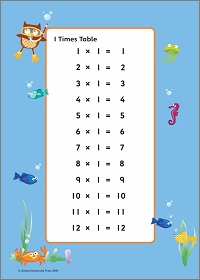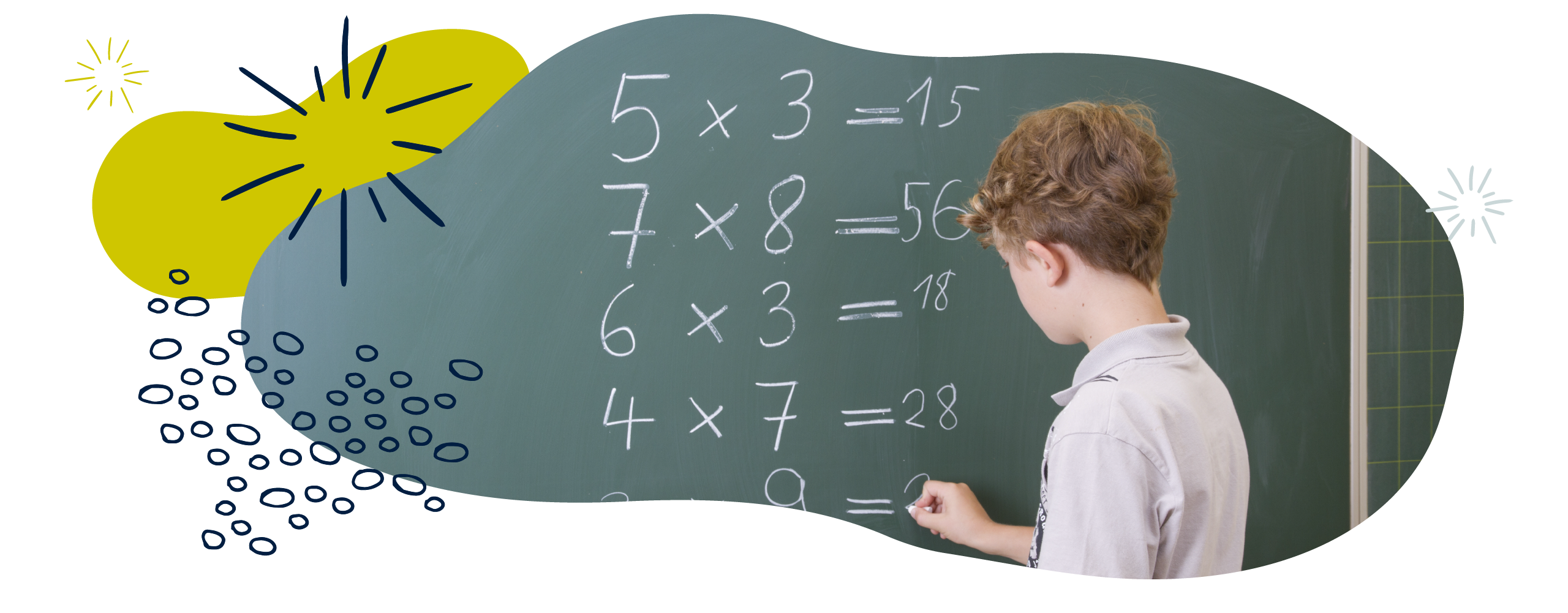Multiplication & division in Year 2 (age 6–7)
In Year 2, your child will solve multiplication and division problems using the 2, 5, and 10 multiplication tables. They will use the ‘×’, ‘÷’, and ‘=’ symbols to record calculations.
The key words for this section are commutative, array, and inverse operations.
What your child will learn
Take a look at the National Curriculum expectations for multiplication and division in Year 2 (age 6–7):
Learn the 2, 5, and 10 times tables
Your child will be introduced to the times tables this year. Children will work out and begin to know facts in the 2, 5, and 10 times tables and connect them to each other. They will be also be able to work out related division facts. For example:
Your child might know that 5 × 7 = 35.
From this, they can work out related division facts: 35 ÷ 7 = 5 and 35 ÷ 5 = 7.
Your child will also be expected to recognise odd and even numbers up to 100.
Use the multiplication (×), division (÷), and equals (=) signs
Show that multiplication can be done in any order (and division cannot)
Your child will learn that when they are multiplying numbers, they get the same product no matter what order they multiply the numbers. This means that multiplication is commutative. For example:
10 × 5 = 50
5 × 10 = 50
Your child will learn that the order of the numbers does matter when using division. This means that, unlike multiplication, division is not commutative. For example:
10 ÷ 5 = 2
5 ÷ 10 = 0.5
Solve problems in contexts using lots of different methods
Your child will learn a variety of methods to calculate multiplication and division problems. For multiplication, these might include:
-
- Counting in steps of 2, 5 or 10 mentally
- Using objects or drawing pictures
- Using number lines to count forwards in steps
- Using the bar model or area/grid method.
They may solve division problems by:
-
- Sharing or grouping objects equally
- Using a number line to count backwards in steps of 2, 5 or 10
- Using their understanding of inverse to use multiplication to work out division problems. For example, when solving 8 ÷ 2, children may count in steps of two to find out how many groups of 2 there are in 8.
Your child will be expected to choose a method to solve a problem and to be able to check their answer using a different method. They will also be expected to explain how they have solved a problem, and to talk about why they chose a particular method.
How to help at home
There are lots of quick and easy ways that you can help your child to understand multiplication and division. Here are just a few ideas to support your child’s learning:
1. Talk about odd and even numbers
Ask your child to explain what they know about odd and even numbers. For example, you could ask your child if 8 is an odd or an even number. If you want to help them understand better, everyday objects such as buttons or pasta are great for learning about odd and even numbers.
Even numbers can be divided equally into two whole numbers, and odd numbers cannot. To find out if a group of objects is odd or even, your child could therefore share them into two equal groups. If the objects can be shared equally between two groups, then the number of objects is even. If the objects cannot be shared equally between two groups, then the number of objects is odd.
Ask your child about odd or even numbers whenever you see an opportunity. For example, is there an odd number of apples in the bags at supermarkets? Is there an odd or even number of people eating dinner tonight?
Help your child recognise that the last digit (the ‘ones’ digit) of even numbers will always be 0, 2, 4, 6, or 8 and that last digit of odd numbers will always be 1, 3, 5, 7, or 9. The rest of the digits in the number don’t matter. Show your child a number such as 36 and ask them if the number is odd or even and ask them to explain why. For example, 36 is even because the ones digit is 6, which is an even number.
2. Practise multiplication
Arrays
Your child will explore multiplication using arrays. Arrays are sets of objects arranged in rows and columns to make a rectangle. Help your child recognise arrays in the real world. Egg boxes, ice cube trays, and windows in a building can all be arrays.
You could play a game with your child to spot arrays when you are travelling to school or going on a walk. It could also be a good idea to ask your child to build arrays from small objects like grapes or buttons. Can they arrange the objects into different arrays? For example, 6 objects can be made into several different arrays:

Times tables
Your child will be introduced to times tables at school. The focus this year will be on the 2, 5, and 10 times tables.
Find out what multiplication facts your child already knows, and then see if they can work out more. For example:
Your child might already know that 2 × 5 = 10.
They could use this to work out 2 × 6 by adding another group of 2 to make 12.
Write down the multiplication tables for the 2, 5, and 10 times tables on individual pieces of paper or sticky notes. Ask your child to choose a multiplication calculation such as 8 × 5 and explain how they would work out this problem. If your child knows the answer immediately, ask them what other facts they know. Challenge them to beat the clock when they are reciting their multiplication facts!
Activity: Times tables wall charts

Charts for all times tables from 1–12.
3. Practise division
Division can be best understood as sharing and grouping.
Division by sharing
Ask your child to explore division by sharing objects equally. For example:
8 ÷ 2 could be solved by sharing 8 toys into 2 equal groups.
The answer is 4, because each group has four toys.
Toys, pieces of pasta, and buttons are all good to practise with. Ask your child to find out how many objects there are to begin with. Can they share the objects equally between the two of you? Help them to share objects one at a time between the two groups. When all the objects have been shared, ask your child how many there are in each group. If you have the same number, explain that your child has shared the objects equally into two groups which is the same as dividing by two.
If you do not have the same number, ask your child if the objects have been shared equally. For example, ‘we started with 11 objects and shared them into two groups and I have 6 objects and you have 5 objects. Are they equal? If they are not equal then 11 cannot be shared equally into two groups so 11 cannot be divided by 2 equally using whole numbers or objects.’
Video: How to do division by sharing
Division by grouping
It’s important that your child also understands division as grouping. Again, you can use any objects from around your home to practise division as grouping.
Ask your child to find out how many there are in a group of toys or pieces of fruit. Explain to them that you want to find out how many groups of two there are in the total group. Help your child to take two items at a time and count how many groups of two there are in the total number.
For example, if you had 8 objects and wanted to divide by grouping this could be seen as ‘How many groups of 2 are there in 8?’. Ask and support your child to explain that they have divided the 8 objects by grouping them in twos and finding out how many groups of 2 there are in the total group of 8 objects.
Video: How to do division by grouping
4. Find connections in multiplication and division
It will be helpful for your child if they can make connections in multiplication and division. Encourage them to explore the connections between multiplication, arrays and repeated addition.
In terms of division, encourage your child to:
-
- Use grouping, sharing, and arrays
- Think about the relationship between division and repeated subtraction
- See the connections between fractions and division (for example, 40 ÷ 2 = 20, 20 is half of 40).
You can also help your child use commutativity and inverse relationships to solve calculations. For example:
If they know that 4 × 5 = 20, then they know 5 × 4 = 20 because multiplication is commutative (i.e. can be done in any order).
If they know that 4 × 5 = 20, then they know 20 ÷ 5 = 4 and 20 ÷ 4 = 5 because multiplication and division are inverse operations.

Arrays also provide a great opportunity for children to explore the connections between multiplication and addition, as well as multiplication and division. Give your child a multiplication calculation from the 2, 5, or 10 times tables and ask them to tell you or write down any other related addition, multiplication or division facts. Talking through how they know each fact will help them to understand how the operations relate to each other.
5. Use the language of multiplication and division
It’s helpful to be able to use the language of multiplication and division when talking with your child. Multiplication language includes product, multiply, multiple, times, repeated addition, equal groups, and array. Division language includes divide, sharing equally, grouping equally, arrays, and remainder.
You can help your child learn these terms by asking them to use this language to explain how they solved a problem. It may be helpful to have the mathematical words written on cards for your child to refer to.
You could also make or print out multiplication and division words cards and ‘×’ and ‘÷’ symbol cards. Help your child read each card and then sort the cards into words that describe multiplication (×) or division (÷). Are there any words that could be placed in both groups? Talk with your child about why these words. This will help them to understand the links between multiplication and division.
